I am in the middle of nowhere and absolutely terrified. All around me, long strips of white canvas stretch into the distance, suspended above the grass; the wind plays them like strings, making them howl and snap. They are precisely at the level of my neck, and their edges appear razor-sharp. Walking through Keisuke Matsuura’s brilliantly simple Resonance, with its multiple slacklines stretched across two small rises, is like going through a dangerous portal, or navigating a set of laser-beams.
Keisuke Matsuura resonance Socle du Monde Biennale 2017 from Keisuke Matsuura on Vimeo.
Matsuura’s work is part of the 7th Socle du Monde Biennale in Herning, Denmark. To get there, we drive through an industrial estate in the middle of grey flatlands. Steam billows from a chimney nearby, and a massive hardware store flanks the Biennale’s terrain, which consists of manicured green lawns dotted with several buildings, and intercut by a road or two. Rather than ruining the experience, the encroaching elements of daily life make for a compelling, unpretentious backdrop to the art on display.
Matsuura’s work is typical of this Biennale, where things that appear simple, even mundane, suddenly swallow you up in an intense encounter. Even the main building, Denmark’s HEART museum, is a surprise. At first glance it appears to be an unobtrusive, white-walled specimen of Scandi minimalism, but when I happen to look up, I see a beautifully menacing ceiling whose folds and texture resemble parchment or flesh.
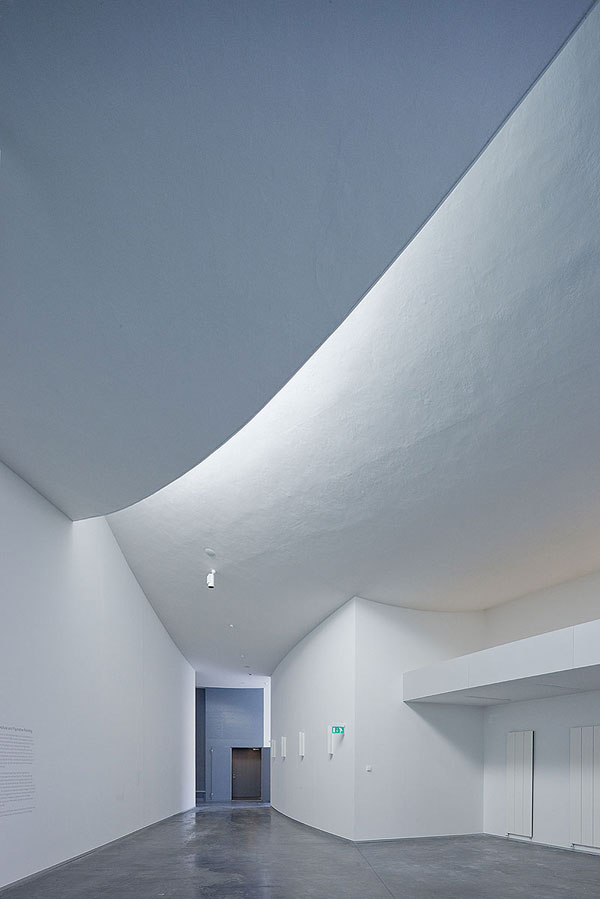
HEART – Herning Museum of Contemporary Art, Denmark. Photo: Steen Gyldendal
This edition of the Socle Biennale, like all the previous ones, is centred around the work of artist Piero Manzoni, who is probably most famous for his merda d’artista (artist’s shit) – chic little packages, each of which contain exactly what it says on the tin, and which Manzoni not only successfully sold for the price of gold, but placed in collections across the world, including those of MoMA and Tate.
Before my visit, I must admit to wondering whether the whole Biennale would be one big scatological, satirical happening. There is indeed a bit of it – Belgian artist Wim Delvoye’s enormous Super Cloaca installation invites audiences to feed neatly chopped pieces of bread and vegetables into a tank containing an artificial digestive system. It is amusing to see ‘The Poop Show’ (the ceremonial switching on of Delvoye’s piece), listed just a few lines beneath the ‘opening with HRH the Prince of Denmark’ on the Biennale’s glossy programme, and to witness well-heeled guests feed the Cloaca with one hand while clutching champagne glasses in the other. But there is much more to both Manzoni and the Biennale.
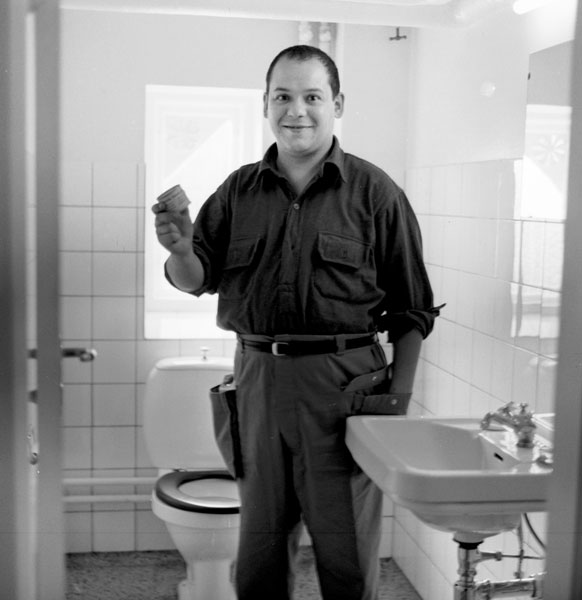
Piero Manzoni with Merda d’artista (1961). Photo: Ole Bagger. Courtesy of HEART
The HEART museum owns the largest public collection of Manzoni works in the world, and many of them – such as White in White, where, through a peephole, you see nothing but a blaze of white – are beautiful, even transcendent. The Biennale programme is divided into seven chapters, each of them dedicated to one of Manzoni’s works or ideas. The artist’s round face grins mischievously at us from various photos on display in the museum, but Nanda Vigo, an artist and designer who worked closely with him, tells me that he was no enfant terrible. Driven but not frenetic, deeply philosophical and introverted, Manzoni was, says Vigo, ‘nothing like a clown.’ The exhibition shows how Manzoni strove to create maximum impact with minimal means – with surfaces that are drained of colour but otherwise reveal a plethora of material possibilities. His works can be fluffy or smooth, made of steel or of light.

Lichtballet by Otto Piene; installation view at the Socle du Monde Biennale 2017. Courtesy of Elizabeth Goldring Piene and Otto Piene Estate Private collection. Photo: Jens Wolter
Manzoni died very young, at the age of 29, but he was prolific and in constant exchange with others, including the international Zero group, a loose artists’ collective dedicated to making radical, minimalistic art and which counted Yves Klein and Jean Tinguely among its associates. In the past when I’ve seen their creations, I’ve thought little of them – glimpsing a forlorn white grid in a gallery or museum, I would pass by in favour of more exciting exhibits.
But here they feature in large numbers, wonderfully arranged by Mattijs Visser, and on seeing them I experience that delicious sensation when something that once seemed meaningless, suddenly becomes spectacular. Occasionally, it is wonderful to be proven wrong. It turns out that these colourless and angular works can be fleshy, like in Enrico Castellani’s canvases; a cubist play on dimensions, as in Nanda Vigo’s Chrono Topo, or a delicate and painful confrontation, like in Otto Piene’s Lichtballet, which was inspired by the tiny holes in the blackout paper that covered his windows during the Second World War.
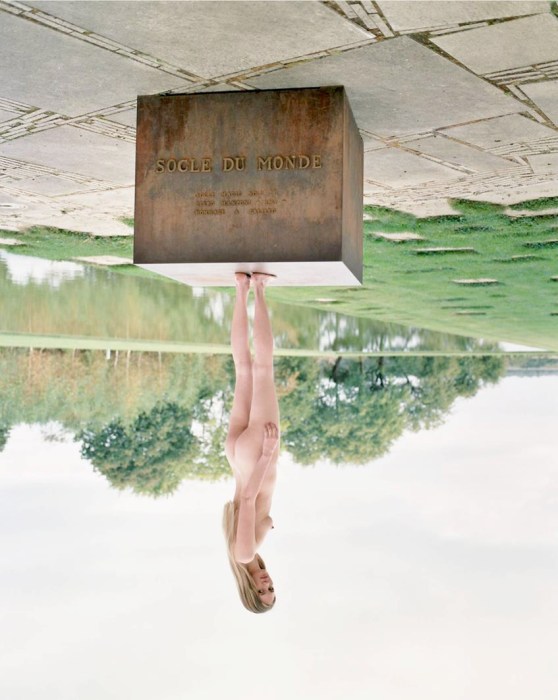
Socle du Monde (2016), Spencer Tunick. Courtesy of the artist
Stepping back outside into the cold, I admire images of three larger-than-life inhabitants of Herning, who undressed in the middle of their town to be photographed by Spencer Tunick. They are posing on Manzoni’s upside-down pedestal of 1961 – the Socle du Monde (‘Foundation of the World’) that gave the Biennale its name. The early morning light creates a magical yet stark atmosphere for Tunick’s pictures, and this and the movingly confident stance of one of his models – a tattooed, middle-aged gentleman – linger in my mind for a long time. Once more, the mundane and the monumental are merged.
The most surprising exhibits, however, are found inside the grey block of Herning’s Højskole (art school), whose inherent drabness is dispelled by two spectacular interventions curated by Olivier Varenne and Martin Guinard-Terrin. On entering the building, which looks like a 1970s youth hostel, I hear the clucking of chickens. It turns out that I am witnessing an ongoing, 25-year-long biological experiment by Belgian artist Koen Vanmechelen, who has been crossbreeding national chicken species such as the French poulet de Bresse or the English redcap.
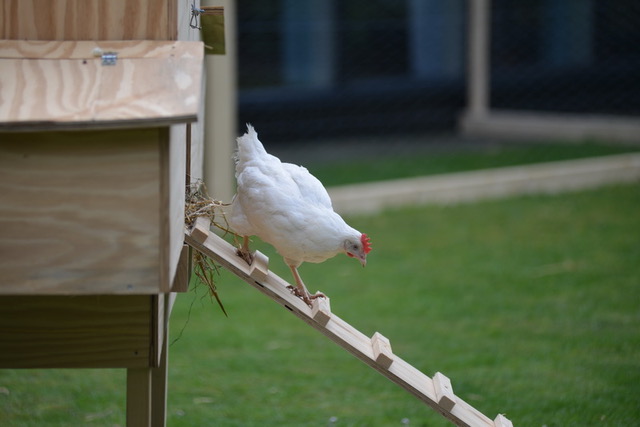
Planetary Community Chicken by Koen Vanmechelen; installation view at the Socle du Monde Biennale 2017. Photo: Ole Jørgensen
Although it was initiated as a symbolic, artistic project highlighting the harmful artificiality of national boundaries, Vanmechelen’s cross-breeding programme has resulted in a particularly strong, ultra-resilient and international superspecies – so successful that the livestock will soon be introduced in at-risk areas to combat hunger and poverty. Vanmechelen’s installation records the entire span of his creation, and next to cases of eggs, there is a tumble of fluffy, freshly hatched chicks. Assuming that nothing can top the poignancy of these adorable hatchlings, I am once again proven wrong when I enter a dark room and find a modified robot – normally used for car-assemblage – performing a lonely dance to music in Conrad Shawcross’s The ADA Project.
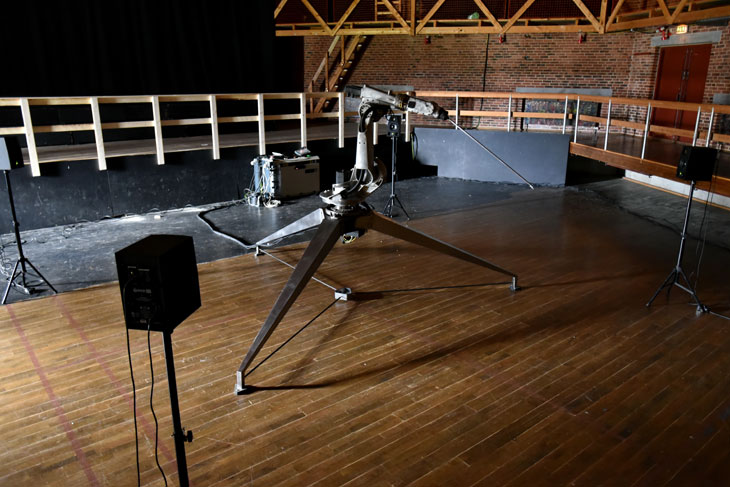
The ADA Project by Conrad Shawcross; installation view at the Socle du Monde Biennale, 2017. Photo: Ole Jørgensen
The only sour note in an otherwise remarkable chapter of the Biennale is The Eye in the Mask curated by Jean-Hubert Martin. Inside the Carl-Henning Pedersen & Else Alfelts Museum, a stunning building containing CoBrA murals and mosaics, Romuald Hazoumé from Benin has reconstructed a sacred ceremonial costume from what he calls ‘trash’, in an impassioned criticism of the display of sacred masks in Western museums. It is therefore rather surprising, and jarring, to see the final room filled with exactly this kind of ethnographic display – a gathering of African masks, with all their contested heritage, and only one mask made of refuse by Hazoumé as a critical footnote.
Otherwise, Socle du Monde has been a singular and rewarding experience. Walking to the various buildings through the greyness and cold of the landscape acts like a mental palate cleanser, allowing me to take in many more works than I would have, had they all been in the same building. Leaving the Biennale is different, too: there is no jarring awakening to the business of the outside world but rather a soft landing back into real life, allowing the artists’ strange white grids and dancing machines to linger in the mind for a long time.
The 7th Socle du Monde Biennale in Herning, Denmark runs until 27 August 2017.
Unlimited access from just $16 every 3 months
Subscribe to get unlimited and exclusive access to the top art stories, interviews and exhibition reviews.

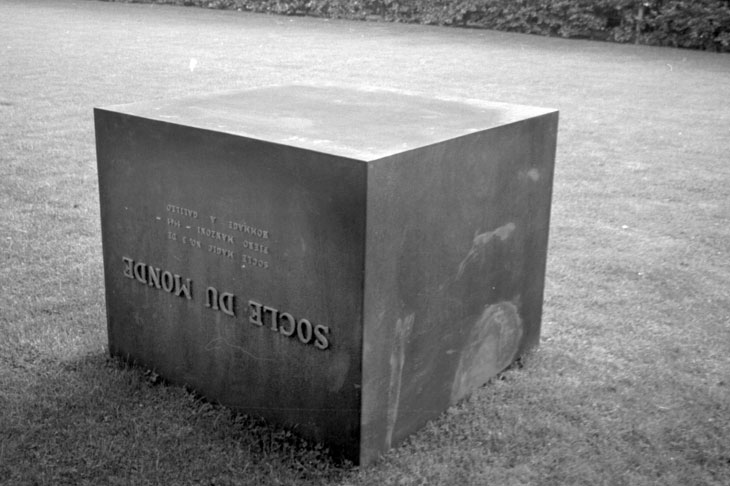









![Masterpiece [Re]discovery 2022. Photo: Ben Fisher Photography, courtesy of Masterpiece London](http://www.apollo-magazine.com/wp-content/uploads/2022/07/MPL2022_4263.jpg)
It’s time for the government of London to return to its rightful home